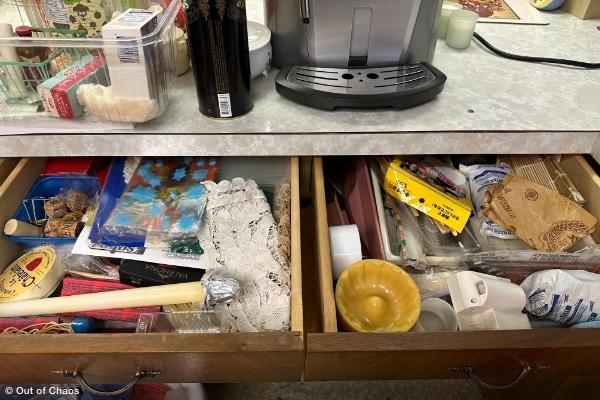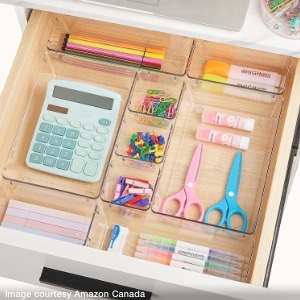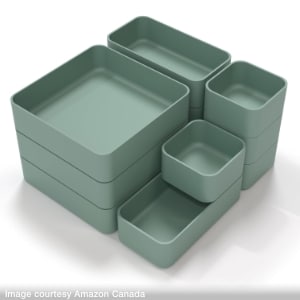
Do you have junk drawer syndrome? Almost every home we organize and every family we move has at least one junk drawer. According to Wikipedia, the concept of junk drawers appeared in North America around the 1900s. The Out of Chaos team typically finds them in kitchens but also in home offices, workshops, and bedrooms.
What’s In a Junk Drawer?
To be honest, even though junk drawers are called junk drawers, they don’t necessarily contain junk. Of course, we find items like broken pens, dead batteries, and bent paperclips, but most things in junk drawers are quite useful.
Generally, these useful things do not always fit into other pre-defined categories in the room where you keep them. For example, a kitchen junk drawer might contain postage stamps, pens, pads of sticky notes, paperclips, and a multi-head screwdriver. Typically, the stamps, pens, sticky notes, and paperclips belong in the office, and the screwdriver belongs in a toolbox.
Junk drawer syndrome arises because of convenience. Putting these random items into a drawer instead of returning them to where they might belong is handy. It’s also convenient to have them in the location where you often need them. It’s a dilemma, that’s for sure!
Steps to Cure Junk Drawer Syndrome
The first step is to empty the drawer and declutter its contents. Ideally, remove the drawer from the cabinet and dump everything onto a hard surface such as your countertop. I recommend covering the surface with an old (but clean) towel to protect the surface from scrapes and scratches. Then, use the C.L.E.A.R. process to deal with the contents of the junk drawer.
Categorize: Group the items into similar categories. For example, put all the office supplies into one group, the tools in another, and the kitchen gadgets in another. While sorting, you can toss/recycle unwanted items such as pens that don’t write, dead batteries, broken paperclips, etc.
Limit: Decide how many of each item you will keep. Then, only put back what you need in the space. For example, you might need to write notes, so keep one pad of sticky notes and one or two pens. Store the extras elsewhere. Likewise, if you don’t need to keep spare batteries in a kitchen drawer, find another home for them.
Evaluate: Reevaluate the name “junk drawer” because reframing your language helps reorient your thoughts and behaviour. You will be less likely to dump “junk” in the drawer if it is called something else. For example, you might call it a Utility Drawer. Depending on the contents, you could call it an Office Supplies Drawer or Tool Drawer.
Allocate: Next, arrange what you will keep in the drawer. Keep what you most often use near the front and items you use less frequently in the back. Compartmentalize the items in drawer organizers. See the section below for details about drawer organizers.
Remove, Return, and Review: Take a few minutes to toss the waste (recycle or trash) and return other items to their proper home. Finally, set an appointment with yourself to review the contents of your “not-junk-anymore-drawer” to ensure it doesn’t become cluttered again. You could tidy every other Saturday or whenever you’re on the phone waiting on hold.
Drawer Organizing Containers
Before you run out to the store or open your internet browser and start shopping, it is essential to measure your drawer and the contents! You don’t want to purchase containers to hold your pens if the containers are too small for your pens.
You can use many different types of containers to organize your “formerly-known-as-junk” drawers. Some of them are large, one-piece inserts divided into sections, while others are a series of smaller containers that fit together. Personally, I prefer the latter. Smaller containers are easy to re-arrange, so they are adaptable when the contents of the drawer change or if you move to a new home with differently sized drawers. Here are a few of my favourite styles.
- These transparent plastic containers come in various sizes that fit almost any drawer. They have no-slip “feet” on the bottom and are very easy to clean. They are perfect for bathrooms and kitchens.
- I like these stackable plastic containers because you can take advantage of the space in deeper drawers. They would be ideal for storing a small container of paper clips stacked on a larger container of pens and pencils.
- Bamboo drawer organizers are at the top of my list for those who prefer natural materials.
For people on a budget or anyone who wants to customize their drawer organization, check out my article on Where to Spend and Where to Save on Organizing Products. You’ll see how an Out of Chaos client used gift boxes and cereal boxes to organize drawers. You could even use older food storage containers. Creative types and those with children might want to spend time decorating the boxes with gift wrap, wallpaper scraps, or washi tape.
Function then Beauty
If you’re unsure what type of drawer organizers to buy, focus on functionality first. In fact, you could use cardboard boxes for a few weeks before choosing drawer organizers. Then, you will have a better idea of the containers you need.
Remember, overcoming junk drawer syndrome is about establishing a thoughtful and systematic approach to what you store in the space. Using the C.L.E.A.R. process and appropriate drawer organizing containers, all your essentials will be at your fingertips. And if you need some hands-on assistance, contact the Out of Chaos team and let us show you how.


